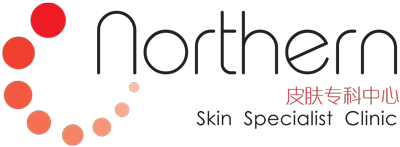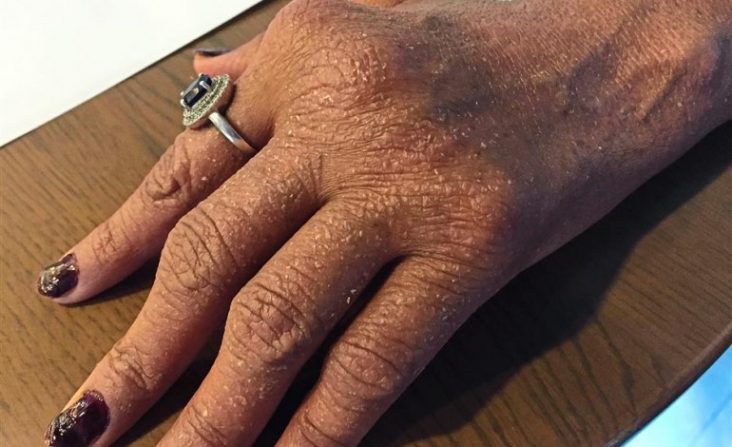Psoriasis is a genetically predetermined, immune-mediated, long-term inflammatory disease that primarily affects the skin and joints.
To date, more than 40 susceptible gene locations have been identified; the more prominent one being HLA cw-6 on the PSOR-1 locus and CARD4.
Psoriasis patients commonly present with red/pink plaques of thickened, scaling skin.
The plaques and thick scales are caused by rapid proliferation of skin cells triggered by inflammatory chemicals produced by white blood cells called lymphocytes.
The same inflammatory chemicals can also attack the joints, causing joint pain (arthritis) and deformity if left untreated.
Psoriasis is NOT a contagious disease, and therefore, it does not spread from close contact and touching. It is also NOT cancerous.
Who gets it?
Not all individuals who have the susceptible gene will have the disease. The disease expression itself depends on complex interactions between genetic and environmental factors.
About 20% of Malaysian psoriasis patients have family members with psoriasis.
The risk of, and aggravating factors for, getting psoriasis include:
• Positive family history of psoriasis
• Alcohol consumption
• Smoking
• Obesity
• Stressful life events
• Infections
• Injury/trauma to the skin of a susceptible person, such as cuts, abrasions or sunburn
• Medications (such as lithium, beta blockers, anti-malarials)
• Stopping oral/injectable steroids
About 1-3% of the world’s population suffer from psoriasis. In Malaysia, patients with psoriasis account for 2-6% of new dermatology clinic attendees within a year (according to a study published in the Medical Journal of Malaysia).
Currently, there are more than 12,000 patients registered with the Malaysian Psoriasis Registry. We believe this figure is just the tip of the iceberg, with a lot more patients not coming forward for treatment or not diagnosed.
Both men and women are equally affected. It can start at any age, with peaks of onset at 15–25 years and 50–60 years.
Psoriasis tends to be lifelong, although it fluctuates in extent and severity.
There are five subtypes of psoriasis (based on skin morphology).
The most common type is plaque psoriasis, seen in about 80-90% of all psoriasis patients. It typically presents with red/pink raised plaques with sharp outlines, thick silvery scales and symmetrically distributed over the trunk and limbs.
Other types of psoriasis include guttate psoriasis (the same plaques as plaque psoriasis, but much smaller in size), pustular psoriasis (small pus-filled yellowish blisters surrounding psoriasis plaques), inverse psoriasis (lesions at the fold-areas like armpits, groin, buttocks and below the breasts) and erythrodermic psoriasis (the most severe form of psoriasis, with generalised skin redness, dryness and scaling involving more than 90% of the body surface).
There are also types of psoriasis that are limited to certain parts of the body.
Scalp psoriasis (plaques only present over the scalp) and palmoplantar psoriasis (only palms and soles are involved) are examples of these limited variants, and they are commonly misdiagnosed as other diseases like eczema or dandruff.
Psoriasis can also affect the joints and nails. Joint involvement (psoriatic arthritis) can be debilitating to a patient as it causes a lot of pain and may lead to severe joint deformities.
Psoriatic arthritis may cause redness, swelling and pain to any joint, although the joints of the hands, knees and ankles tend to be most commonly affected.
Nail changes that may be seen in psoriasis include pitting over the nail plate, separation of the nail plate from the nail bed, and total nail dystrophy in the worst case scenario.
Nail involvement is typically very difficult to treat and is associated with increased risk of getting psoriatic arthritis.
Diagnosis and treatment
Psoriasis is a very “visible” disease, so it has significant negative impact on patients’ quality of life.
Psoriasis patients often experience difficulties like maladaptive coping responses, problems with body image, low self-esteem, and also, feelings of stigma, shame and embarrassment regarding their appearance.
It has been linked to depression and suicidal tendencies in patients. A study has shown that as high as 10% of patients with psoriasis have contemplated suicide.
Besides that, delay in diagnosis of psoriatic arthritis may lead to severe deformity and will significantly affect the active daily activities of psoriasis patients.
Furthermore, recent studies have shown that psoriasis can be associated with other medical conditions, including obesity, metabolic syndrome, heart disease, inflammatory bowel disease (Crohn’s disease and ulcerative colitis) and uveitis (inflammation of the eye).
These complications can be reduced by controlling psoriasis disease activity with effective treatment.
Most of the time, diagnosis is made clinically when typical plaques are noted from physical examination of the skin, further strengthened by information obtained from medical history and relevant family history.
If you have any skin lesions with features suggestive of psoriasis, make an appointment to see a dermatologist. Not all psoriasis-like lesions are due to psoriasis.
Your doctor will carry out further investigations to determine the diagnosis.
Lab tests involving microscopic examination of a skin biopsy (skin sampling tissue) may be needed. The skin biopsy is usually indicated for cases with atypical presentation.
Patients with psoriasis should ensure they are well informed about their condition and its treatment.
There are benefits from not smoking/stopping smoking, avoiding excessive alcohol and maintaining ideal weight.
Many effective treatment options are available for psoriasis. The main treatment choices are:
Topical (skin applied) treatment: This is the treatment of choice for mild disease, involving small areas of the body.
Topical treatment comes in various forms like creams, ointments, lotions, sprays and shampoos. It can be quite effective and is relatively safe to use if applied correctly.
Types of topical medications include topical corticosteroids, topical vitamin D analogues, topical retinoids, moisturisers, topical coal tars (made from pine tar), topical immune modulators and anthralin.
Phototherapy (light therapy): Used for more extensive disease in conjunction with topical treatment, phototherapy is administered by shining ultraviolet (UV) light of certain wavelengths at psoriasis plaques.
Types of phototherapy include PUVA, narrow band UVB and excimer laser.
Phototherapy is relatively safe and effective. However, it isonly available in certain major public hospitals in Malaysia.
Furthermore, patients need to come to the hospital at least twice a week for three to six months if they are subject to phototherapy.
Therefore, logistical problems and availability of service may limit the usage of phototherapy.
Systemic therapy (oral medication, injection): Systemic therapy is indicated for more severe diseases and patients with joint involvement (to prevent permanent joint destruction).
Systemic therapy is generally more potent and effective, but it is also associated with more side effects and toxicity. Frequent blood investigations may be needed if patients are put on systemic therapy.
Examples of oral medications commonly used to treat psoriasis are methotrexate, acitretin and cyclosporine.
Injection forms of treatment include methotrexate and biologics.
Biologics are bioengineered proteins designed to block specific molecular steps important in the genesis of psoriasis.
They are one of the more advanced treatment modalities, and are more effective compared to conventional therapies.
Biologics are only indicated if patients have failed or are intolerant to all conventional therapies.
The unclear long-term and potentially serious side-effects, and cost (RM40,000 to RM60,000 annually, depending on the type of biologics), remain the biggest stumbling block for biologics treatment.
Overall, the best treatment for psoriasis is individually determined by the treating physician.
It will depend on type of disease, severity, personal preferences, availability of the treatment and co-morbidities.
Unfortunately, as yet, there’s no cure for psoriasis. However, it can be effectively controlled with current modern treatment.
Ongoing research is still being actively carried out to decipher the ultimate underlying cause, and hopefully, to discover a cure for this disease.
World Psoriasis Day
World Psoriasis Day (October 29) is an annual day specially dedicated to people with psoriasis/psoriatic arthritis. Conceived by patients for patients, it is a global event that sets out to give an international voice to the 125 million people with psoriasis/psoriatic arthritis.
On Saturday (Nov 7), Persatuan Penyayang Pesakit Psoriasis Pulau Pinang (PPPPPP), Persatuan Psoriasis Kedah (PPK), Persatuan Dermatologi Malaysia (PDM), Department of Dermatology, Hospital Pulau Pinang, Hospital Sultanah Bahiyah, Kedah, and Hospital Raja Permaisuri Bainun, Ipoh, will be organising a Skin Health Day, in conjunction with World Psoriasis Day 2015 for northern Malaysia, at Padang Polo, George Town, Penang (7am-2pm), to raise awareness and knowledge about basic skin care and common skin disorders, in particular, psoriasis/psoriatic arthritis, and give people with psoriasis the attention and consideration they deserve. For details about the event, please refer to https://www.facebook.com/skinhealthday2015.
Dr Khor Yek Huan is a consultant dermatologist. This article is courtesy of the Dermatological Society of Malaysia.

 Tue-Fri 10:00-20:00
Tue-Fri 10:00-20:00
 +604-638 3393 / +6010-399 7713
+604-638 3393 / +6010-399 7713
 B-2-1, Bay Avenue, Bayan Lepas
B-2-1, Bay Avenue, Bayan Lepas
